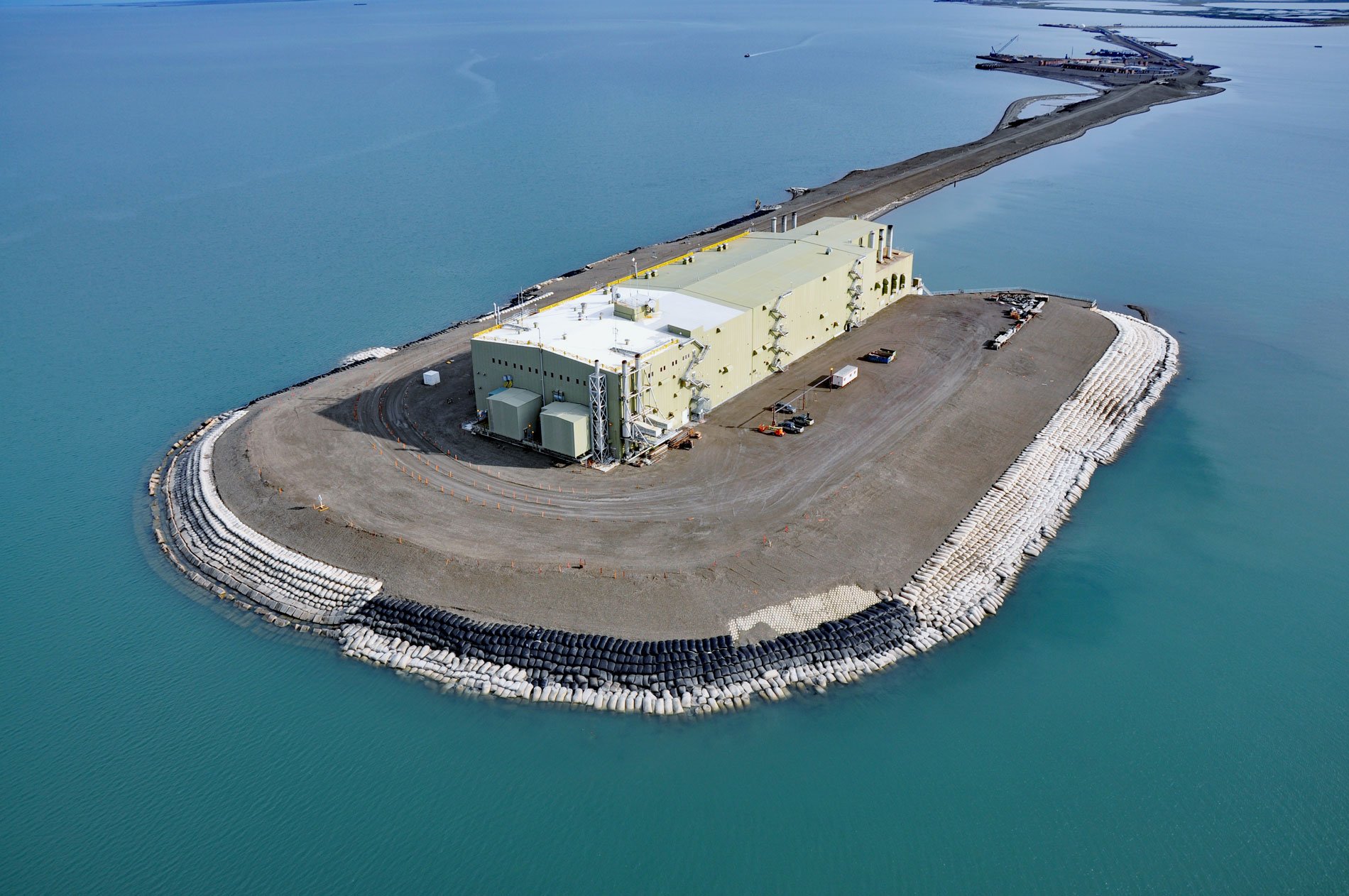West Dock Causeway was constructed in the Beaufort Sea between Gwydyr Bay to the west and Prudhoe Bay to the east in support of oil exploration and to access a seawater treatment facility 2.5 miles (4.3 km) north from the mainland, about 59 miles (95 km) northeast of Nuiqsut and 15 miles (24 km) north of Deadhorse, Alaska. Prudhoe Bay was named in 1826 by British explorer Sir John Franklin to honor Algernon Percy, 4th Duke of Northumberland and Baron Prudhoe, of Prudhoe Castle in Northumberland, England. Prudhoe Bay is the principal settlement along the Beaufort Sea and is the center of petroleum production on the coastal lowland known as the North Slope. The Trans-Alaska Pipeline System carries crude oil south from Prudhoe Bay to Valdez in Prince William Sound. The Beaufort Sea was named in 1826 also by Franklin for Sir Francis Beaufort who was the hydrographer to the British Admiralty. Four water masses characterize the Beaufort Sea, a cold surface layer, a warmer subsurface layer that originates in the Bering Sea and Pacific, a deep layer of warm Atlantic water, and cold bottom water. The currents follow a clockwise Arctic Ocean gyre and flow along the coast from east to west. The continental shelf of the Beaufort Sea is narrow and shallow with many barrier islands and lagoons. The ocean and lagoons are typically ice covered except for August through September, and even then, it is often only open near the coast. The mainland consists of the Arctic Coastal Plain which is low-lying and almost entirely permafrost covered with tundra and shallow lakes.
A large expansion in petroleum development occurred at Prudhoe Bay between 1973 and 1983 when the Trans-Alaska Pipeline was built and became operational. By 1983, offshore development had increased to include artificial gravel islands for exploratory drilling, and the construction of West Dock to replace East Dock as the main port facility. Construction began in the winter of 1974 to 1975 and the causeway extended about 3,600 feet (1100 m) north into the Beaufort Sea from the northwest shore of Prudhoe Bay. In the first year of operation, supply barges became trapped in sea ice about 4,800 feet (1463 m) from shore and emergency permits were granted to extend the causeway to a depth of 6 to 7 feet (2 m) at about 7,920 feet (2,414 m) from shore. Regulatory agencies became concerned about the impacts of solid-fill causeways on coastal circulation and the migration of fish and marine mammals. Several studies to assess the impacts of the West Dock causeway were initiated but the results were inconclusive. In 1979, an extension of an additional 4,560 feet (1,389 m) was proposed to a water depth of 12 feet (3.6 m) for the construction of a seawater intake and treatment plant for waterflooding, a secondary process to extract oil from existing wells. This extension was completed in 1981, which brought the total length to 13,200 feet (4,023 m) including a bridge that spans a channel 52 feet (15.8 m) wide to facilitate passage for fish and small boats. The causeway was also widened to accommodate additional utilities and provide a roadway 39 feet (12 m) wide and 18 feet (5.5 m) above mean sea level.
Waterflooding or water injection is used by the oil industry to increase pressure in the oil field and thereby stimulate production. Water injection wells can be found both on and offshore to increase oil recovery from an existing reservoir. Water is injected to pressurize the reservoir and to push oil towards a well. Normally only 30 percent of oil in a reservoir can be extracted, but water injection increases that percentage and maintains the production rate of a reservoir over a longer period. In 1983, a mammoth barge-mounted seawater treatment plant, designed to treat up to 2 million barrels of seawater per day, was docked permanently at the end of the West Dock causeway. Continued development of the Prudhoe Bay oil field and satellite reservoirs on the North Slope has required the construction of two gravel causeways, the other at Endicott in the Sagavanirktok River delta. These solid-fill structures have caused obvious changes in the nearshore hydrography, circulation, ice formation, upwelling, nearshore sediment transport, and likely disrupted the migration of fish and marine mammals. For example, during the summers of 1985 to 1993, the effects of the causeways on feeding and migratory patterns of least cisco and arctic cisco were analyzed. During two of the four years in which juvenile least cisco were abundant in the study area, catch rates were significantly lower east of West Dock, suggesting that small fish traveling from west to east along the coast failed to bypass the causeway. Another study indicated that humpback whitefish dispersing eastward along the coast from their overwintering grounds in the Colville River had been blocked by the causeway. In response, a channel about 650 feet (200 m) wide was constructed in the winter of 1995 to 1996 near the base of the causeway to allow fish passage. Read more here and here. Explore more of West Dock and Prudhoe Bay here:

